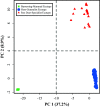Demographic Expansions and the Emergence of Host Specialization in Genetically Distinct Ecotypes of the Tick-Transmitted Bacterium Anaplasma phagocytophilum
- PMID: 35867580
- PMCID: PMC9317897
- DOI: 10.1128/aem.00617-22
Demographic Expansions and the Emergence of Host Specialization in Genetically Distinct Ecotypes of the Tick-Transmitted Bacterium Anaplasma phagocytophilum
Abstract
In Europe, genetically distinct ecotypes of the tick-vectored bacterium Anaplasma phagocytophilum circulate among mammals in three discrete enzootic cycles. To date, potential ecological factors that contributed to the emergence of these divergent ecotypes have been poorly studied. Here, we show that the ecotype that predominantly infects roe deer (Capreolus capreolus) is evolutionarily derived. Its divergence from a host generalist ancestor occurred after the last glacial maximum as mammal populations, including roe deer, recolonized the European mainland from southern refugia. We also provide evidence that this host specialist ecotype's effective population size (Ne) has tracked changes in the population of its roe deer host. Specifically, both host and bacterium have undergone substantial increases in Ne over the past 1,500 years. In contrast, we show that while it appears to have undergone a major population expansion starting ~3,500 years ago, in the past 500 years, the contemporary host generalist ecotype has experienced a substantial reduction in genetic diversity levels, possibly as a result of reduced opportunities for transmission between competent hosts. IMPORTANCE The findings of this study reveal specific events important for the evolution of host specialization in a naturally occurring, obligately intracellular bacterial pathogen. Specifically, they show that host range shifts and the emergence of host specialization may occur during periods of population growth in a generalist ancestor. Our results also demonstrate the close correlation between demographic patterns in host and pathogen for a specialist system. These findings have important relevance for understanding the evolution of host range diversity. They may inform future work on host range dynamics, and they provide insights for understanding the emergence of pathogens that have human and veterinary health implications.
Keywords: Anaplasmataceae; Capreolus capreolus; Rickettsiales; arthropod vector; enzootic cycles; host range.
Conflict of interest statement
The authors declare no conflict of interest.
Figures





References
Publication types
MeSH terms
LinkOut - more resources
Full Text Sources
Miscellaneous

